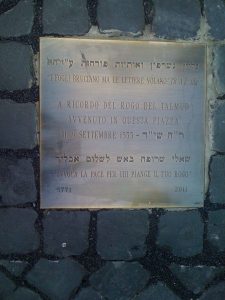
Italy and the Talmud long share an entangled history. The first complete edition of the Babylonian Talmud to be printed on the modern-day printing press was in Venice, in the year 1520 by Daniel Bomberg, who interestingly enough was Christian. However, in 1553, on Rosh Hashanah, copies of the text were publicly burnt in the Campo dei Fiori, a central marketplace in Rome, by the Roman Inquisition, headed by then-Cardinal Garafa, soon to become Pope Paul IV.
Fast-forward some 458 years where Talmudic and Italian histories were once again being created and shared. In 2011, Professor Clelia Piperno, of the University of eramo, CEO of PTTB, approached Rabbi Riccardo di Segni, Chief Rabbi of Rome, with the concept of creating a translation of the Babylonian Talmud. While the translation would be primarily geared for the Italian Jewish community of around 30,000 to be able to comprehend the complexity of the text, which was oft-restricted to them due to lack of understanding, Clelia had a bigger vision. Aside from the ultimate translation, she wished for the act of the translating itself to be an art. It would lead to an inclusion project, not just for the Jewish people, but for promoting Italian heritage and cultural growth as well. It would create a revolutionary tool in research, science and technology, empowering and influencing a global system of knowledge – just like the Talmud itself. Her ideals were actualized when the Italian government awarded the project with 11 million Euros in funding.
Enter TRADUCO. Traduco is innovative translation software created especially for this project. It is designed to process text and knowledge according to the principles of computational linguistics, which will allow the system to eventually suggest possible translations from its own database using an algorithm. Translators enter the text taken from the Rav Aiden Steinsaltz Nekudot Talmud (which PTTB bought the rights to in 2013) line by line, dividing it into strings allowing for the initial decoding to take place.
The system is web-based, conceiving a global community of 90 researchers and translators who work from wherever they may be, while simultaneously allowing each other to view their work in real-time. This allows them to assist and guide each other resulting in a product that is the most authentic translation of the Talmud while keeping true to the original text. Rabbi Gadi Piperno, a quality manager at PTTB, described to me the process in which the translation goes through three levels of quality inspection to make sure that the end result is correct literally and flows cohesively from beginning to end.

How does a project of this magnitude on the Talmud, a predominately male subject, work when it’s being run by a woman? “I have one word for that,” explained Professor Clelia Piperno, while addressing the crowd at a recent luncheon in Manhattan celebrating the accomplishments of The Babylonian Talmud Translation Project. “Respect. I respect them and they respect me.”
Tractate Rosh Hashanah was the first to be completed. “We chose to start with Rosh Hashanah because that was the day the Romans burnt the Talmud in Campo dei Fiori,” explained Rabbi di Segni, adding, “We sold 10,000 copies in the year following its publication and there are plans of integrating it into the school system.” Currently, they are finishing the work on Tractate Brachot, the first tractate in the Babylonian Talmud, and have plans for its release.
PBBT also went to Washington where they presented a copy of Tractate Rosh Hashanah to the Library of Congress. Traduco in Italian means “I Translate,” the infinitive verb is “tradurre,” which can be translated as “transform.” This is a fitting name for a project of such magnitude, which hopes to be able to translate and transform the cultural landscape of its home country for the current and future generations.
You must be logged in to post a comment.